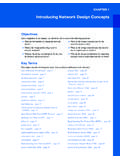Transcription of 5G Network Architecture: Standard Progress, and ...
1 5G Network architecture : Standard progress , and tranfromation to SBA and Network Slicing Wei Chen, China Mobile 2 5G Network architecture Standard progress 5G Network funtional archiitecture transformation: SBA 5G Network funtional archiitecture transformation: Network slicing Activities on SBA and Network slicing Summary Contents 3 Overall Timeline of 5G architecture in 3 GPP Nov Q1 Q2 Q3 Q4 Q1 Q2 Q3 Q4 2015 2016 2017 2018 2019 Phase I Study Phase 2 Study 5G Phase 1 Stage 3 Finalize on June Normative work Started 3 GPP SA1 already finished 5G requirement(SMARTER) specification TS in March, 2017 3 GPP SA2 Started Study on architecture for Next Generation System (NextGen) from Nov.
2 2015. After one year study, NextGen is completed in Nov. 2016, with output 3 GPP TR Phase 2 study is expected to be started in Q2 2017 Based on the study, the 5G System-Phase 1 is started. Two Specifications will be generated TS : System architecture for the 5G System TS : Procedures for the 5G System 4 Separate User Plane (UP) functions from the Control Plane (CP) function, allowing independent scalability, evolution and a flexible deployment centralised location or distributed (remote) location. Modularize the function design, to enable flexible and efficient Network slicing.
3 Wherever applicable, procedures ( the set of interactions between Network functions) are defined as services. Minimizes dependencies between Access Network (AN) and Core Network (CN), the architecture is defined with a converged access-agnostic core Network with a common AN - CN interface which integrates different 3 GPP and non-3 GPP access types. Support a unified authentication framework. Support "stateless" NFs, where the "compute" resource is decoupled from the "storage" resource. Support capability exposure. Concurrent access to local and centralized services is supported.
4 To support low latency services and access to local data networks, UP functions can be deployed close to the radio Network . Some key Principles and Concepts 5 Hot Topics in 5G Phase 1 Study 316 301 291 234 163 101 95 84 75 52 24 16 14 70 050100150200250300350 Key technology Number of contributions NextGen Study Item identified 22 key issues, 14 of them are foundermental for 5G Eight key issues: Network slicing, QoS, mobility management, session management, migration and interworking, non-3 GPP access, modularization and interface (service based interface) New architecture is mostly interested 6 5G Network is Designed as Service-based architecture (SBA) A single 5G architecture but the interaction between Network functions is represented in two ways It is intended that 5G Control Plane Network Functions (NF)
5 Exhibit their functionality via service-based interfaces, so that the NF services can be flexibly used by other authorized NFs. UE(R)ANUPFAFAMFSMFPCFUDMDNN6 NRFNEFN3N2N4 AUSFN ausfNamfNsmfNpcfNnrfNnefNudmNafAMFPCFUE( R)ANUPFDNN13N7N3N6N2N4N1 AFN5 SMFN11N9 AUSFN8N12 UDMN10N14N15 Representation 1: 5G System architecture Service-based interface Representation 2: 5G System architecture in reference point representation Transition from Network function to Network function service 7 Key Features of 5G architecture slicing: a logical Network that provides specific Network capabilities and Network characteristics.
6 Remove bearer concept, use flow based QoS mechanism management: new MM state RRC_inactive to reduce the assess time and power consumption; On-demand Mobility management: SM separated with UP, SM separated with MM, user plane: support edge computing, On-demand session continuity control: introduce Network Data Analytics (NWDA) Mobile convergence: natively support unified authentication and non-3 GPP access Service-based architecture Network Slicing 8 What is Service-based architecture of 5G? An NF service is one type of capability exposed by an NF (NF Service Producer) to other NF (NF Service Consumer).
7 System procedures are built by invocation of a number of NF services. NF_A (Consumer) NF_B (Producer) Producer Request Response NF_A (Consumer) NF_B (Producer) Producer Subscribe Notify Two type of primitive operations: Request-response and Subscribe-Notify Service-based architecture is defined with Network function service + Service-based interface NF service is expected to be self-contained, reusable and use management schemes independently of other NF services offered by the same Network Function ( for scaling, healing, etc).
8 9 Why Service-based architecture is important for 5G? Benefits of 5G Service-based architecture Updating Production Network -Services operate with finer granularity than in legacy networks and are loosely-coupled with each other allowing individual services to be upgraded/extended with minimal impact to other services. -Operational benefits such as shrinking testing and integration timescales (moving towards continuous integration) which reduces the time to market for installing bug fixes, and rolling out new Network features and operator applications Extensibility -Comparing to the legacy hop-by-hop model, service based interfaces can be easily extended without introducing new reference points -Each service can interact directly with other services with light-weighted service based interface (SBI)
9 Modularity & Reusability -The Network is composed of modularized services, which reflects the Network capabilities, and can be leveraged by 5G features such as Network slicing; -A service can be easily invoked by other services (with certain authorization), enabling each service to be reused as much as possible; Openness -Together with some control functions ( authentication, authentication), service based interface can be easily exposed to external users such as 3rd-party application provider 10 Why Service-based architecture (SBA) is Challenging?
10 New design New Interaction Performance Operator Capability SOA MSA SBA Service-based architecture is a big thing for Restful API VS. Peer to peer signalling A Network function is defined by a couple of services MicroService architecture ~2012 Service-Oriented architecture ~early 2000s Service-based architecture 2016 Transforming functional architecture 11 Network slicing: customized Network provision Slice 1: eMBB BBU UPF(simplified) Slice 2: mIoT BBU AMF Service 1 Network slicing enables flexibly building logical and E2E 5G mobile Network with differentiated Network capabilities, including RAN, CN , transport, and even including UE , Gi service deployed and third party application Guaranteed performance to vertical industry Network slice as a service, opened to vertical customers UPF(Complicated )






